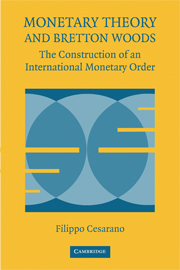Book contents
- Frontmatter
- Contents
- Preface
- Acknowledgments
- 1 INTRODUCTION
- 2 INTERNATIONAL MONETARY EQUILIBRIUM AND THE PROPERTIES OF THE GOLD STANDARD
- 3 THE INTERNATIONAL MONETARY SYSTEM BETWEEN THE WORLD WARS
- 4 THE MONETARY SYSTEM IN ECONOMIC ANALYSIS: THE CRITIQUE OF THE GOLD STANDARD
- 5 THE GREAT DEPRESSION: OVERTURNING THE STATE OF THE ART
- 6 PROVIDING FOR A NEW MONETARY ORDER
- 7 THE BRETTON WOODS AGREEMENTS
- 8 BRETTON WOODS AND AFTER
- References
- Author Index
- Subject Index
5 - THE GREAT DEPRESSION: OVERTURNING THE STATE OF THE ART
Published online by Cambridge University Press: 18 December 2009
- Frontmatter
- Contents
- Preface
- Acknowledgments
- 1 INTRODUCTION
- 2 INTERNATIONAL MONETARY EQUILIBRIUM AND THE PROPERTIES OF THE GOLD STANDARD
- 3 THE INTERNATIONAL MONETARY SYSTEM BETWEEN THE WORLD WARS
- 4 THE MONETARY SYSTEM IN ECONOMIC ANALYSIS: THE CRITIQUE OF THE GOLD STANDARD
- 5 THE GREAT DEPRESSION: OVERTURNING THE STATE OF THE ART
- 6 PROVIDING FOR A NEW MONETARY ORDER
- 7 THE BRETTON WOODS AGREEMENTS
- 8 BRETTON WOODS AND AFTER
- References
- Author Index
- Subject Index
Summary
In the aftermath of 1929, the international monetary system suffered a fatal blow and the theoretical debate took a new course. Whereas in the 1920s policymakers had sought to make the changes that would allow the restoration and improvement of the gold standard, in the 1930s the way that system worked came to be seen as a cause of the crisis, intensifying the calls for reform. The movement away from the commodity standard quickened, and policymakers were assigned an active role in stabilizing not just the price level but also income and employment. With the definition of instruments and targets, a full-fledged concept of monetary policy as the central banker's solution of an optimization problem came to be widely shared among economic theorists. Monetary arrangements had to be revamped to match that concept, a task whose accomplishment met with substantial difficulties.
The interaction between theoretical advances and exogenous shocks, the driving force of the evolution of the international monetary system, was quite intense in the crisis-ridden interwar years, especially after the onset of the depression, which stimulated intensive research activity and was inevitably policymakers' overriding concern. The further move away from commodity money, widening the discretion and the functions exercised by monetary authorities, highlighted the role of theory in molding innovative rules of the game. Knowledge of the direction in which economic analysis advanced is thus essential for an understanding of the reform proposals that would emerge in the early 1940s.
- Type
- Chapter
- Information
- Monetary Theory and Bretton WoodsThe Construction of an International Monetary Order, pp. 100 - 130Publisher: Cambridge University PressPrint publication year: 2006



